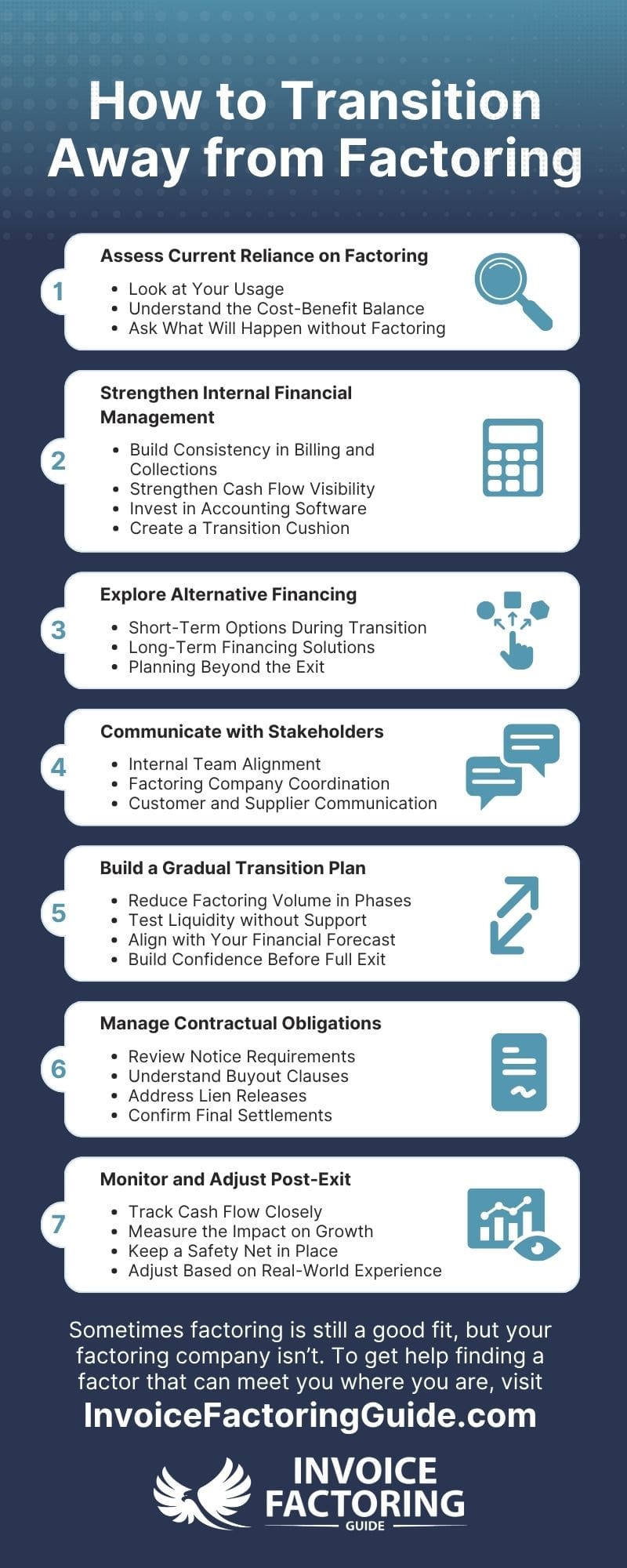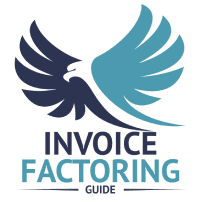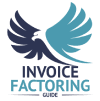
Preparing your business for a factoring exit? The transition is typically smooth, but there are a few things you’ll want to address to ensure you can maintain steady cash flow and don’t run into contractual issues along the way. In this guide, we’ll explore factoring exit strategies and go over step-by-step instructions, so the next leg of your journey gets off on the right foot.
Why Businesses Leverage Factoring
When you first considered factoring, chances are you had a clear reason: you needed cash in hand sooner than your customers were willing to pay. That challenge is far more common than many business owners realize.
Cash Flow Relief
More than half of all small businesses say uneven cash flow is one of their greatest financial challenges, according to the latest Small Business Credit Survey. Paying operating expenses rates slightly higher, with 56 percent reporting challenges. This is often a symptom of the cash flow challenges, simply because customer payment terms often stretch 30 or more days. Meanwhile, you still have payroll, supplier costs, and operating expenses that do not wait. Factoring allows you to turn those unpaid invoices into immediate cash.
Access without Traditional Lending Hurdles
Factoring is often the most realistic option available when bank loans are out of reach. It’s a common situation, with just 39 percent of business loan applicants receiving full approval, per the Small Business Credit Survey. Factoring fills this gap because, unlike a loan, it does not require years of financial history or strong collateral. Instead, your customers’ invoices serve as the asset. That gives businesses access to working capital without taking on new debt.
Flexibility That Moves with Your Growth
With each new invoice, you have the option to unlock more working capital. That flexibility is one reason industries like trucking, staffing, and manufacturing rely heavily on factoring. Demand often shifts quickly, and funding has to move just as fast.
Time Back for What Matters
Smooth business operations and factoring go hand-in-hand. For instance, many businesses eliminate stress by allowing a factoring company to manage collections and generate invoices for them. Instead of spending hours prepping and chasing overdue invoices, you can focus on delivering services, building customer relationships, or exploring growth opportunities.
When to Stop Using Factoring
Factoring can be a powerful tool, especially during the early stages of growth or when customer payment terms create strain. But as your business matures, there often comes a point when shifting away from factoring aligns better with your long-term goals.
Stronger Cash Flow Foundations
If your business has built consistent reserves, steady payment cycles, and reliable collections, you may find that you no longer need the same level of support from factoring. That is a good sign. It means your cash flow systems are standing on their own.
Access to Other Financing Options
As your company grows, lenders often become more willing to extend traditional credit. A bank line of credit, for example, can provide ongoing access to capital at a lower overall cost once you qualify. Many businesses use factoring as a stepping stone until they reach this stage.
Cost Considerations at Scale
Factoring fees are predictable and worthwhile when you need immediate liquidity. Over time, though, if your transaction volume grows significantly, you may find the cumulative cost of factoring higher than traditional financing. That does not make factoring a poor choice. It means your business has advanced to the point where different financial tools may be more efficient or where factoring costs and profit margins don’t align.
Strategic Growth Planning
Sometimes the decision is less about cost and more about strategy. If you are preparing for expansion, an acquisition, or a major capital investment, you may want longer-term financing solutions that provide stability over several years. Transitioning away from factoring can free you to pursue those opportunities.
Step-by-Step Exit Strategy from Factoring

Now that we’ve covered the background, let’s explore the steps involved in factoring transition planning and exiting.
1. Assess Current Reliance on Factoring
Before you can plan an exit, you need a clear picture of how much you rely on factoring today. Think of it like running a health check on your business finances.
Look at Your Usage
- Invoice Volume Factored: How many of your invoices are going through factoring each month? Is it just a portion, or nearly all of them?
- Frequency: Are you factoring every invoice cycle, or only during certain busy periods?
- Length of Use: Have you been factoring for a few months to cover growth, or for several years as a core part of your cash flow strategy?
Understand the Cost-Benefit Balance
- Fees Paid: Add up what you have paid in factoring fees over the past six to 12 months.
- Cash Flow Value: Compare those fees against the value of receiving your money early. For many companies, the speed of cash far outweighs the cost, especially when it prevents missed payroll or late supplier payments.
- Additional Services: When you consider the value factoring brings, bear in mind that you’ll now be handling your own customer credit checks and collections. If you’re tapping into things like load boards, fuel cards, and tire discount programs, and they won’t be available when you stop factoring, include any related increased costs in your estimates, too.
Evaluate What Would Happen without Factoring
Ask yourself: if you stopped factoring tomorrow, what gaps would appear? Would you have enough cash on hand to cover your obligations, or would there be a shortfall? Running this kind of stress test will show you whether your business is truly ready to move forward without factoring.
2. Strengthen Internal Financial Management
Factoring has likely given your business the breathing room it needed. As you look toward transitioning away, it is essential to put systems in place that keep your cash position steady without outside support. Think of this as building your financial foundation before exiting factoring.
Build Consistency in Billing and Collections
- Clear Invoicing Processes: Send invoices promptly and make sure they are accurate. Small errors can create big delays.
- Collections Procedures: Have a structured follow-up plan for outstanding invoices. For example, send a reminder at 15 days, then follow with a call at 30 days. This creates predictable inflows.
Strengthen Cash Flow Visibility
To keep your business steady, you need to see what is coming before it arrives. This is where cash flow forecasting best practices come in. Develop weekly or monthly forecasts that map out expected income against expenses. Include variables like seasonal fluctuations, large customer orders, or equipment purchases. The goal is to anticipate cash gaps before they happen.
Invest in Accounting Software
Up to 70 percent of small businesses still manage their financial reporting via spreadsheets, according to Forbes research. Not only is this cumbersome, but it can lead to costly errors. Consider moving to a program like QuickBooks, Zoho Books, or FreshBooks to improve speed and accuracy.
Create a Transition Cushion
As you move forward, focus on maintaining cash flow during transition. This often means building a reserve fund where you set aside a portion of revenue each month until you have enough to cover at least one or two payroll cycles. That way, you are not caught off guard if a customer pays late.
- Cash Flow Forecasting: Build cash flow projections that show when cash comes in and goes out, so you can anticipate needs.
- Collections Processes: Tighten invoicing and follow-up to reduce delays.
- Reserves: Begin building cash reserves to cushion periods when customer payments are slow.
3. Explore Alternative Financing to Factoring
Factoring can give you stability during critical stages, but as your business evolves, it makes sense to explore other tools. Having options lined up ensures a smooth transition and keeps your business flexible once you move beyond factoring. We’ll explore some options and what to keep in mind when choosing financing options for SMEs below.
Short-Term Options During Transition
Sometimes you still need extra liquidity while reducing reliance on factoring. Common approaches include:
- Negotiating Payment Terms: Work directly with suppliers or customers to adjust when payments are made. For example, extending payables from 30 to 45 days, or shortening receivables from 60 to 30 days, can ease pressure.
- Business Credit Cards or Overdraft Protection: Cover smaller gaps without needing to factor every invoice by using commercial credit cards or having overdraft protection set up.
- Spot Factoring: Although you’re still factoring, a spot factoring arrangement is more flexible because you choose which invoices to factor and aren’t generally tied to monthly minimums.
Long-Term Financing Solutions
Once your business has stronger reserves and consistent cash flow, it is time to look at more sustainable tools. Your existing factoring company, banks, and lenders may be willing to offer:
- Lines of Credit: A line of credit can provide access to capital that you can draw on as needed, often at a lower cost than factoring.
- Asset-Based Loans: Financing tied to receivables, inventory, or equipment is known as asset-based lending. These options can bridge the gap between factoring and fully independent financing.
- Term Loans or Expansion Loans: Options like term loans are best suited when you have predictable growth opportunities that require capital.
Planning Beyond the Exit
It is important to remember the impact of factoring on cash flow. You have likely grown accustomed to receiving funds quickly. Once you move away, that timing shifts. To keep momentum, explore financing solutions post-factoring that match your business model. For example, a trucking company might benefit from a revolving line of credit, while a manufacturer may find equipment financing more useful.
- Bank Financing: A line of credit or term loan from a bank may be the most practical option once you qualify.
- Asset-Based Lending: You can sometimes use receivables or other assets as collateral to secure a loan.
- Equity or Investor Funding: In some industries, bringing in outside investors may make sense.
4. Communicate with Stakeholders
The people who depend on your business, both inside and outside your company, need to understand what is changing and how it will affect them. Clear communication helps prevent confusion and builds confidence.
Internal Team Alignment
Your finance staff and leadership team should know exactly how the transition will unfold. Sales and operations teams may also need context, since customer payment terms and credit decisions often influence their work. When everyone understands the plan, you reduce the risk of mixed signals or unexpected disruptions.
Factoring Company Coordination
Your factoring partner is one of the most important stakeholders in a factoring transition. If you’ve been assigned an account manager, reach out for guidance. Every agreement has its own requirements, such as notice periods, invoice cutoffs, or lien releases. Talking openly with your factoring company ensures you meet those obligations and avoid unnecessary complications.
Customer and Supplier Communication
In some cases, customers or vendors may notice changes in how invoices are managed. By explaining adjustments in a straightforward way, you maintain trust and prevent uncertainty. For example, if customers are used to paying your factor directly, you will want to give them clear instructions once payments start flowing back to you.
5. Build a Gradual Transition Plan
Things will go smoother if you reduce your reliance in stages. That way, you can test your financial systems, build reserves, and catch potential issues before they become major problems.
Reduce Factoring Volume in Phases
Instead of factoring every invoice, try scaling back in steps:
- Partial Factoring: Start by sending only a portion of invoices through your factor each month.
- Seasonal Factoring: Use factoring only during peak times when cash flow is stretched.
- Selective Factoring: Advance funds on invoices from customers who are slower to pay, while managing others directly.
Test Liquidity without Support
As you reduce factoring, track whether your cash reserves are enough to handle obligations like payroll, rent, and supplier payments. Think of this as a stress test. If you discover gaps, you still have factoring in place as a backstop.
Align with Your Financial Forecast
Match your step-down approach to your cash flow forecasts. For example, if you know a large customer is scheduled to pay in 60 days, you might choose to factor fewer invoices leading up to that point. This prevents short-term strain while still allowing you to move toward independence.
Build Confidence Before Full Exit
Gradual reduction gives you the reassurance that your systems work without outside funding. By the time you fully transition away, you will have proof that your business can stand on its own financial strength.
6. Manage Contractual Obligations

Every factoring contract comes with terms you need to follow, and handling them correctly ensures a clean, professional transition.
Review Notice Requirements
Most agreements require written notice before termination of factoring. This can range from 30 days to 90 days, depending on the contract. Marking those dates on your calendar early prevents last-minute surprises.
Understand Buyout Clauses
If you are in a recourse factoring agreement, you may need to repurchase invoices that are still outstanding when you exit. Knowing that obligation ahead of time helps you plan reserves or alternative financing to cover it.
Address Lien Releases
Factoring companies often file a UCC financing statement to secure their interest in your receivables. The lien should be released when you stop factoring out of good practice, though it must be released at this time if you plan to use your receivables to secure a loan. Work closely with your factor to make sure the paperwork is filed promptly.
Confirm Final Settlements
Make sure you understand what the final settlement process looks like. This includes reconciling outstanding invoices, paying any fees owed, and confirming there are no open obligations left behind.
7. Monitor and Adjust Post-Exit
To keep your business strong, watch results closely and make adjustments as needed.
Track Cash Flow Closely
Without factoring advances, timing becomes even more important. Monitor your inflows and outflows weekly at first. If you notice gaps, act quickly, whether that means tightening collections, negotiating different payment terms, or drawing on backup financing.
Measure the Impact on Growth
Review how the transition affects your ability to take on new customers, invest in equipment, or handle seasonal spikes. If you find that growth is slowing because of limited cash, it may signal the need for a different financing tool.
Keep a Safety Net in Place
Even if you do not plan to use it, arrange a backup option. This could be a line of credit, a small reserve fund, or even the ability to return to factoring temporarily. Having a safety net reduces risk and gives you confidence to move forward.
Adjust Based on Real-World Experience
Every business will experience the exit differently. Some may find the shift smooth, while others may need to tweak invoicing processes, expand reserves, or revisit financing choices. The important part is to adapt as you learn.
Explore Alternate Factoring Companies
Sometimes factoring is still a good fit for a business, but the company outgrows its factoring partner. For instance, you may explore ending your factoring relationship because you need higher advances, a lower rate, or a different level of service than you’re currently receiving. In these cases, switching factoring companies rather than stopping factoring altogether is often a better choice. If you need assistance finding a factoring company that’s a better fit for your needs, we can help. To get started, request a complimentary rate quote.
FAQs on Factoring and Factoring Exit Strategies
What are some factoring pros and cons for SMEs?
Factoring helps small and medium-sized businesses improve cash flow, cover expenses, and grow without taking on debt. It is flexible, scaling with your sales. However, it does involve fees, and long-term reliance may cost more than traditional financing. Many SMEs use factoring as a stepping stone to other funding.
When should a business stop using factoring?
A business may stop using factoring once it has steady cash reserves, reliable customer payment patterns, or access to lower-cost financing like a line of credit. Transitioning at the right time allows you to keep growing while reducing long-term costs and dependence on external funding support.
How do you transition away from factoring?
The best way to transition is gradually. Start by factoring fewer invoices, strengthening collections, and building reserves. Review your contract obligations and line up other financing options. This step-down approach helps you test liquidity while still having factoring available as a safety net during the shift.
What funding alternatives can be used when you stop factoring?
Alternatives include bank lines of credit, asset-based loans, equipment financing, and negotiating better payment terms with customers or suppliers. Each option has different requirements, so the right fit depends on your company’s size, industry, and financial profile. These tools often become accessible after using factoring to build stability.
What happens to invoices when you leave factoring?
Once you exit, customers typically begin paying your business directly again instead of the factoring company. To avoid confusion, provide clear instructions to customers about the change. You will also want to confirm all outstanding invoices with your factor are settled before transitioning fully.
How long does it take to exit a factoring agreement?
Exit timing depends on your contract. Some agreements require 30 to 90 days’ written notice, while others include buyout clauses for invoices already factored. Reviewing your contract early and coordinating with your factoring company ensures you meet requirements and transition smoothly without unexpected delays.
What are common challenges when leaving factoring?
Businesses often face gaps in cash flow timing once they no longer receive advances. Other challenges include managing collections internally, releasing liens, and securing replacement financing. Careful planning, reserves, and open communication with stakeholders help reduce these risks and make the transition easier to manage.
Can a business return to factoring after exiting?
Yes. Many businesses return to factoring temporarily if they face unexpected growth, customer payment delays, or cash shortages. Exiting does not close the door forever. It simply means you have more flexibility to use factoring when needed rather than relying on it for every cycle.
What are common challenges with business factoring?
Factoring is a reliable cash flow tool, but like any financial solution, it requires planning. Businesses need to manage contract terms, coordinate customer payment instructions, and monitor fees alongside benefits. With clear processes, these challenges are manageable and factoring can continue supporting growth effectively.
What are signs of over-reliance on factoring?
Factoring can be used as much or as little as needed. Signs it may be time to rebalance include factoring every invoice by default, or not building cash reserves. These signals are not negative—they simply suggest it could be useful to explore additional financing tools alongside factoring.

About Invoice Factoring Guide
Related Articles
Get an instant funding estimate
Results are estimates based on the calculated rate and the total invoice amount provided.
Actual rates may vary.
Request a Factoring Rate Quote
PREFER TO TALK? Call us at 1-844-887-0300










